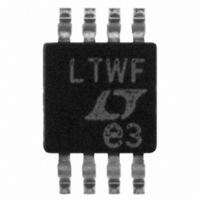LT1767EMS8-5#PBF Linear Technology, LT1767EMS8-5#PBF Datasheet - Page 5

LT1767EMS8-5#PBF
Manufacturer Part Number
LT1767EMS8-5#PBF
Description
IC SW REG STEP-DOWN 5V 8-MSOP
Manufacturer
Linear Technology
Type
Step-Down (Buck)r
Datasheet
1.LT1767EMS8-3.3PBF.pdf
(16 pages)
Specifications of LT1767EMS8-5#PBF
Internal Switch(s)
Yes
Synchronous Rectifier
No
Number Of Outputs
1
Voltage - Output
5V
Current - Output
1.5A
Frequency - Switching
1.25MHz
Voltage - Input
3 ~ 25 V
Operating Temperature
-40°C ~ 125°C
Mounting Type
Surface Mount
Package / Case
8-MSOP, Micro8™, 8-uMAX, 8-uSOP,
Primary Input Voltage
15V
No. Of Outputs
1
Output Voltage
5V
Output Current
1.5A
No. Of Pins
8
Operating Temperature Range
-40°C To +125°C
Msl
MSL 1 - Unlimited
Supply Voltage Range
3V To 25V
Rohs Compliant
Yes
Lead Free Status / RoHS Status
Lead free / RoHS Compliant
Power - Output
-
Available stocks
Company
Part Number
Manufacturer
Quantity
Price
PIN
FB: The feedback pin is used to set output voltage using an
external voltage divider that generates 1.2V at the pin with
the desired output voltage. The fixed voltage 1.8V, 2.5V,
3.3V and 5V versions have the divider network included
internally and the FB pin is connected directly to the
output. If required, the current limit can be reduced during
start up or short-circuit when the FB pin is below 0.5V (see
the Current Limit Foldback graph in the Typical Perfor-
mance Characteristics section). An impedance of less
than 5k (adjustable part only) at the FB pin is needed for
this feature to operate.
BOOST: The BOOST pin is used to provide a drive voltage,
higher than the input voltage, to the internal bipolar NPN
power switch. Without this added voltage, the typical
switch voltage loss would be about 1.5V. The additional
boost voltage allows the switch to saturate and voltage
loss approximates that of a 0.22 FET structure.
V
This pin powers the internal circuitry and internal regula-
tor. At NPN switch on and off, high dI/dt edges occur on
this pin. Keep the external bypass capacitor and catch
diode close to this pin. All trace inductance in this path will
create a voltage spike at switch off, adding to the V
voltage across the internal NPN.
GND: The GND pin acts as the reference for the regulated
output, so load regulation will suffer if the “ground” end of
the load is not at the same voltage as the GND pin of the
IC. This condition will occur when load current or other
currents flow through metal paths between the GND pin
and the load ground point. Keep the ground path short
between the GND pin and the load and use a ground plane
IN
U
: This is the collector of the on-chip power NPN switch.
FUNCTIONS
U
U
CE
LT1767-2.5/LT1767-3.3/LT1767-5
when possible. Keep the path between the input bypass
and the GND pin short. The GND pin of the MS8 package
is directly attached to the internal tab. This pin should be
attached to a large copper area to improve thermal
resistance. The exposed pad of the MS8E package is also
connected to GND. This should be soldered to a large
copper area to improve its thermal resistance.
V
NPN switch. This pin is driven up to the input pin voltage
during switch on time. Inductor current drives the switch
pin negative during switch off time. Negative voltage must
be clamped with an external catch diode with a V
SYNC: The sync pin is used to synchronize the internal
oscillator to an external signal. It is directly logic compat-
ible and can be driven with any signal between 20% and
80% duty cycle. The synchronizing range is equal to initial
operating frequency, up to 2MHz. See Synchronization
section in Applications Information for details. When not
in use, this pin should be grounded.
SHDN: The shutdown pin is used to turn off the regulator
and to reduce input drain current to a few microamperes.
The 1.33V threshold can function as an accurate under-
voltage lockout (UVLO), preventing the regulator from
operating until the input voltage has reached a predeter-
mined level. Float or pull high to put the regulator in the
operating mode.
V
input of the peak switch current comparator. It is normally
used for frequency compensation, but can do double duty
as a current clamp or control loop override. This pin sits
at about 0.35V for very light loads and 0.9V at maximum
load. It can be driven to ground to shut off the output.
SW
C
: The V
: The switch pin is the emitter of the on-chip power
C
pin is the output of the error amplifier and the
LT1767/LT1767-1.8/
sn1767 1767fas
BR
<0.8V.
5

















